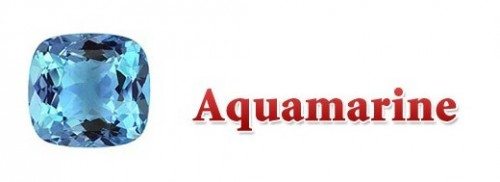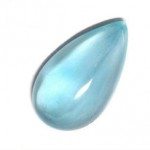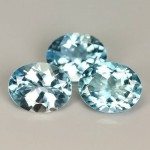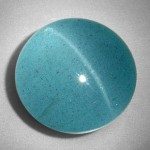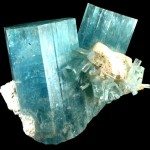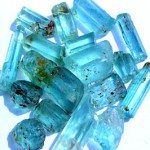Contents
Gemstone Information
Aquamarine is the name given to the blue variety of the Beryl, a mineral family that includes other popular species like the precious Emerald (the green variety and one of the four popular precious stones), Heliodor (the yellow variety), Goshenite (the white colorless variety of Beryl), Morganite (the pink variety), and some more rare variety like Pezzottaite (the vivid reddish pink variety) and Bixbite (the red variety), its name means “water of the sea” in the old Latin expression.
The light blue variety from the beryl mineral family can show different colors in the shade of pale green hue and, from light blue almost colorless, to a very saturated deep blue color hue (this rare variety is sometimes called Maxixe).
Aquamarine is beryllium aluminum silicates, its color is given by the iron impurities present into the colorless beryl crystal, usually transparent with eye clean clarity without visible inclusions, it is a relatively hard stone with hardness ranging from 7.5-8 on the Mohs scale of minerals hardness, present a vitreous to resinous luster, hexagonal prisms crystal structure, no fluorescence and indistinctive cleavage rarely seen.
This variety of Beryl is a relatively common gemstone and can be found in big quantity, and big size gemstones are relatively rare. Aquamarine is very used in the jewelry world duo to its attractiveness, high hardness, affordable cost, color variety.
Click here to purchase genuine Aquamarine gemstones
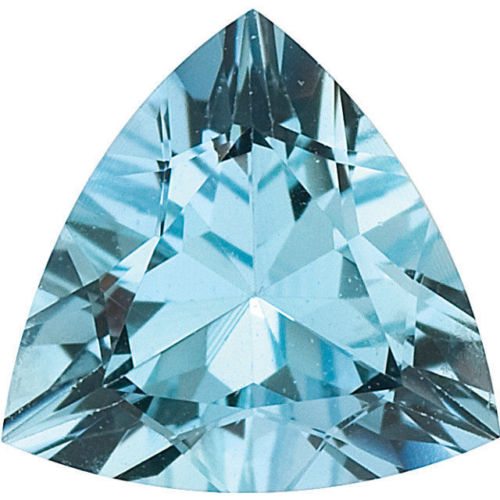
Healing Properties
Considering its name and mythologic origin, it is a water stone, it is also considered a stone for those who spend much of their time at sea like sailors, ancient population like Romans and Greeks consider this stone able to ensure a safe and prosperous passage across stormy seas and protect the people from the sea sickness.
Assigned to the planet Neptune, it is also one of March’s official birthstones.
Wearing Aquamarine gemstone (click here to buy) in contact with the skin, can help for eye inflammation, varicose veins, arthritis.
Aquamarine is also useful for cooling, soothing, and improving communication. It enhances courage, clarity, and intuition. Physically, aquamarine is useful for combating hot flashes, throat problems, and inflammation.
Treatment
A common acceptable treatment for aquamarine gemstone is the heat treatment to remove the light green color tone present in the light green Beryl into a pale light blue stone, exposing stones to a temperature near of 400° C (750° F).
Heat treatment can also improve the color saturation and, change the color tone into a deeper and more saturated vivid blue. Aquamarine gems affected by heat can present some internally cracks that can be translated into a more fragile gemstone.
Origin and Gemstone Source
The biggest producer of this kind of gemstones and crystals is the Brazil, but other mines are located in other different countries like: Africa (Zambia, Nigeria, Madagascar, Namibia, Kenya, Mozambique), Pakistan, Myanmar, India, United States, China, Russia
Optical Effect
Some translucent variety of this mineral variety can be cut into a cabochon and reveal a nice chatoyancy effect, also called Cat’s eye Aquamarine, in very rare scenario can also include a star and show asterism.
Images and Photos
Click here to buy genuine Aquamarine gemstones
Uses
Usually the best quality of flawless crystals are faceted into the most popular shape, like: pear, oval, round, emerald/octagonal, baguette, trilliant, fancy, but can also be cut into cabochon, engraved in sculptures or cut into beads, rondelles, briolette or polished when present opaque clarity.
Care and Cleaning
It is a durable gemstone, usually flawless without visible inclusions, but sometimes it may present some internal cracks that can compromise the hardness of the stone, especially if they are treated by heat, so we suggest to don’t clean your Aquamarine jewels with ultrasonic cleaner, use instead some cold water and soap and dry it with a soft cloth.
Also be careful if you wear you get in contact with chemical products because they can reach with your gemstone and ruin it.
Heat treatment can increase color saturation and enhance the appearance of the stone, but sometimes color can be fade if the gemstone is exposed to direct sun light, we suggest to wear in the night or protect it from rays of the Sun.
Store your beautiful gemstone separately from other variety of gemstone, because gemstone are fragile and can be scratched by harder stones.
Scam and Fraud
This is a relatively cheap stone, and the costs of producing synthetic Aquamarine is not low, so synthetic gemstones are not produced and are not easily found on the gemstone market.
There are some gemstone very similar to this Beryl mineral variety, one of these is blue Topaz that can be easily confused and mistake for Aquamarine, duo to the color very close of the two gemstone variety, some unscoupolous dealers try to scam buyers selling light blue Topaz for Aquamarine.
Other similar gemstones are: synthetic blue Spinel, synthetic hydrotermal blue Quartz, blue Zircon and common glass.
It can also be called with deceptive names from scammers, like:
- Aqua Aura (synthetic man made quartz covered by a thin layer)
- Mass Aqua (dyed faceted quartz)
-
Nerchinsk Aquamarine (name used for blue Topaz sold for Aquamarine)
- Siam Aquamarine (false name used for heat treated Zircon sold for Aquamarine)
Typical Internal Inclusions
Observing internal inclusions in a gemstone is a common process to know what kind of gemstone we are watching, in Aquamarine can be present these kind of inclusions: Liquid filled inclusions with tubes shape; fingerprint inclusions, 2 and 3 phase inclusions.
Gemological Info
- Mineral family: Beryl
- Crystal: Hexagonal
- Density: 2.72
- Hardness:7.5 – 8
- Refractive index: 1.577 – 1.583
- Optic Character: DR Uniaxial negative
- Color: Pale Blue to vivid blue, sometimes present some tint of green
- Cause of color: presence of Iron
- Luster: Vitreous
- Clarity: Type 1 (often eye clean)
- Fluorescent: Inert
- Fracture: Conchoidal
- Cleavage: Rarely seen
- Durability: High
Click here to purchase genuine Aquamarine gemstones

